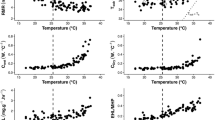Summary
Desert shrews (Notiosorex crawfordi; 4 g) enter into daily bouts of very shallow torpor, when restricted in their food intake. These bouts, though interrupted and uneven, last throughout that portion of the day the animals' cages are lighted. Body temperature is apparently regulated by fine adjustments of metabolic heat production in hypothermic as well as euthermic desert shrews. Thus, these animals seem to have two temperature thresholds for thermoregulation or body temperature rheostat settings. One is near 38 °C while the other, near 28 °C is likely used exclusively when energy supplies are low. The coefficient of heat transfer is the same at both body temperatures. Power saved by hypothermic animals at air temperatures between 20 and 25 °C amounts to about 96 mW. This is half of the metabolic power output of euthermic shrews at 20 °C and 80% at 25 °C. These results suggest a compromise between the energy savings of a deep torpor and the unimpaired functioning of euthermia.
Similar content being viewed by others
References
Dixon, J.: Notes on life history of the gray shrew. J. Mammal.5, 1–6 (1924)
Gebczynski, M.: Oxygen consumption in starving shrews. Acta Theriol.16, 288–292 (1971)
Hainsworth, F.R., Wolf, L.L.: Regulation of oxygen consumption and body temperature during torpor in a hummingbird,Eulampis jugularis. Science168, 368–369 (1970)
Heller, H.C., Glotzbach, S.F.: Thermoregulation during sleep and hibernation. Int. Rev. Physiol.15, 147–188 (1977)
Heller, H.C., Walker, J.M., Florant, G.L., Glotzbach, S.F., Berger, R.J.: Sleep and hibernation: Electrophysiological and thermoregulatory homologies. In: Strategies in cold: Natural torpidity and thermogenesis. Wang, L.C.H., Hudson, J.W. (eds.), pp. 225–265. New York: Academic Press 1978
Hill, R.W.: Daily torpor inPeromyscus leucopus on an adequate diet. Comp. Biochem. Physiol.51A, 413–423 (1975)
Hoffmeister, D.F., Goodpaster, W.W.: Life history of the desert shrewNotiosorex crawfordi. Southwest Nat.7, 236–252 (1962)
Hudson, J.W.: Shallow, daily torpor: A thermoregulatory adaptation. In: Strategies in cold: Natural torpidity and thermogenesis. Wang, L.C.H., Hudson, J.W. (eds.), pp. 67–108. New York: Academic Press 1978
Lasiewski, R.D., Hubbard, S.H., Moberly, W.R.: Energetic relationships of a very small passerine bird. Condor66, 212–220 (1964)
Lindstedt, S.L.: Energetics and water economy of the smallest desert mammal. Physiol. Zool. (in press)
Lynch, G.R., Vogt, F.D., Smith, H.R.: Seasonal study of spontaneous daily torpor in the white-footed mouse,Peromyscus leucopus. Physiol. Zool.51, 289–299 (1978)
Nagel, A.: Torpor in European white-toothed shrews. Experientia33, 1455–1456 (1977)
Vogel, P.: Kälteresistenz und reversible Hypothermie der Etruskerspitzmaus (Suncus etruscus, Soricidae, Insectivora). Z. Säugetierk.39, 77–88 (1974)
Vogel, P.: Energy consumption of European and African shrews. Acta Theriol.21, 195–206 (1976)
Withers, P.C.: Respiration, metabolism, and heat exchange of euthermic and torpid poorwills and hummingbirds. Physiol. Zool.50, 43–52 (1977)
Author information
Authors and Affiliations
Additional information
Supported by NSF: DEB 75-18576 and NIH: AM 05738
Rights and permissions
About this article
Cite this article
Lindstedt, S.L. Regulated hypothermia in the desert shrew. J Comp Physiol B 137, 173–176 (1980). https://doi.org/10.1007/BF00689217
Accepted:
Issue Date:
DOI: https://doi.org/10.1007/BF00689217




